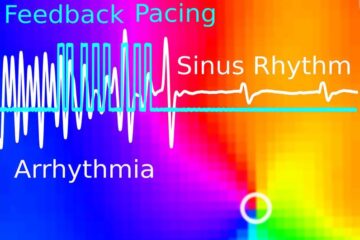The glue that keeps cells together

Snapshots of the bond of a giant vesicle on a plane model membrane. Dark pixels mark the points of contact between the membranes. They grow larger and more numerous over time. (Picture: Susanne Fenz)
Controlled adhesion and division are crucial for our body's cells. This is the case, for instance, when the organs develop in an embryo or when broken skin is repaired during the healing process.
The importance of close cell-cell adhesion becomes evident especially when it is dysfunctional, for example when cells become loose in a tumour and break free. The tumour cell complex tends to dissolve in this case and create metastases.
Cadherins as key actors
The cadherin proteins assume a central role in the above mentioned examples. Located in the cell membranes, they are capable of creating strong bonds both among themselves and with the cadherins of other cells. A bond between two cadherin molecules of two cells triggers the formation of extensive contact zones.
The process of establishing and detaching contacts seems to be much more dependent on purely physical effects than thought previously. This is shown by computer simulations and experiments published in “Nature Physics” by Dr Susanne Fenz from the University of Würzburg's Biocentre with colleagues from Jülich, Stuttgart, Erlangen and Marseilles.
Connecting model membranes
The biophysicist brought together model membranes containing cadherin and then selectively changed different physical parameters that influence the membrane's fluctuation behaviour such as the concentration of sugar and salt.
“We observed that already very small changes had a huge impact on the formation and growth of cell-cell contacts,” says Dr Fenz, who leads a junior research group at the Department for Cell and Developmental Biology (Zoology I). “So it is possible to regulate a biological process by changing only physical parameters such as the temperature or local lipid composition of the membrane.”
But according to Fenz, it is still doubtful to what extent the results for the model membranes can be transferred to living systems. “We will have to confirm the relevance of our observations in living systems,” says Susanne Fenz.
Focus on pathogens that cause sleeping sickness
The Würzburg researcher has a general interest in the biophysics of membranes. For example, she also studies the pathogens that cause the sleeping sickness. The protozoa of the species Trypanosoma are one of Professor Markus Engstler's focal areas of research; he is the head of the Department for Zoology I at the Julius-Maximilians-Universität (JMU) in Würzburg, Germany.
What's special about the cell membrane of Trypanosoma is that it is densely populated with a protein shell that is varied continuously in a population. This high variability of the protein shell allows the pathogens to hide efficiently from the immune systems of animals and humans.
Membrane fluctuations mediate lateral interaction between cadherin bonds. Susanne F. Fenz, Timo Bihr, Daniel Schmidt, Rudolf Merkel, Udo Seifert, Kheya Sengupta & Ana-Sunčana Smith. Nature Physics, 12. June 2017, DOI: 10.1038/nphys4138
Contact
Dr Susanne Fenz, head of the junior research group “Physics of the Cell”, Biocentre of the University of Würzburg, JMU, T +49 931 31-89712, susanne.fenz@uni-wuerzburg.de
http://rdcu.be/tpWy The Nature Physics publication
http://www.zeb.biozentrum.uni-wuerzburg.de/people/staff_scientists/susanne_fenz/ Website of Dr Susanne Fenz
Media Contact
More Information:
http://www.uni-wuerzburg.deAll latest news from the category: Life Sciences and Chemistry
Articles and reports from the Life Sciences and chemistry area deal with applied and basic research into modern biology, chemistry and human medicine.
Valuable information can be found on a range of life sciences fields including bacteriology, biochemistry, bionics, bioinformatics, biophysics, biotechnology, genetics, geobotany, human biology, marine biology, microbiology, molecular biology, cellular biology, zoology, bioinorganic chemistry, microchemistry and environmental chemistry.
Newest articles

Wildfire danger to increase due to climate change
WSL Institute for Snow and Avalanche Research (SLF) researchers expect an elevated wildfire danger in the Alpine Foreland from 2040 onwards due to changing meteorological conditions. The danger currently remains…

Advanced Brain Science Without Coding Expertise
Researchers at Helmholtz Munich and the LMU University Hospital Munich introduce DELiVR, offering a new AI-based approach to the complex task of brain cell mapping. The deep learning tool democratizes…

Gentle defibrillation for the heart
Using light pulses as a model for electrical defibrillation, Göttingen scientists developed a method to assess and modulate the heart function. The research team from the Max Planck Institute for…





















